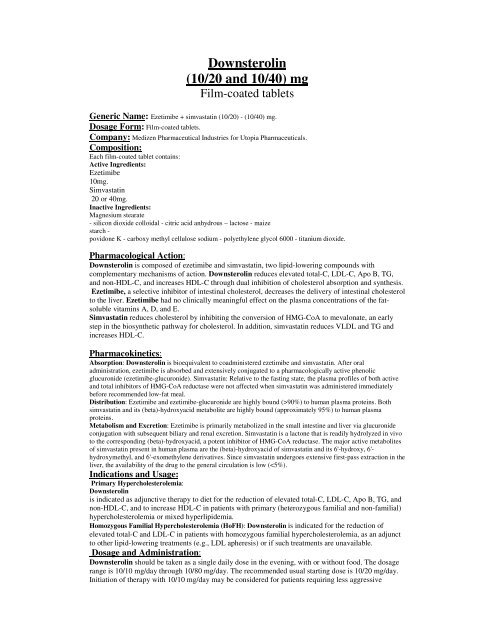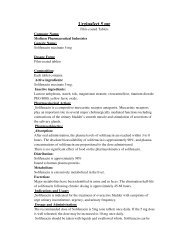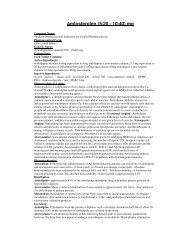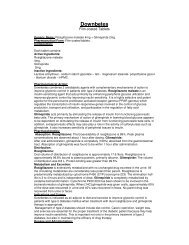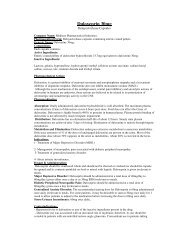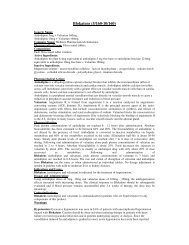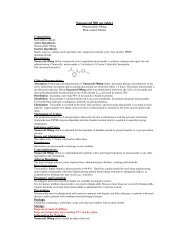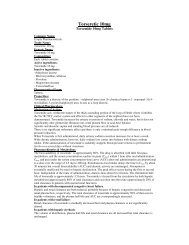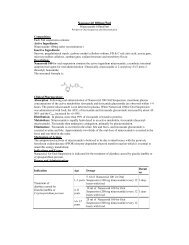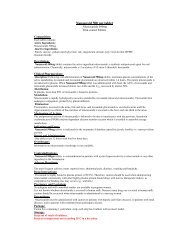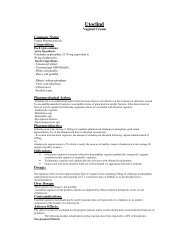Downsterolin (10/20 and 10/40) mg - Utopia Pharmaceuticals
Downsterolin (10/20 and 10/40) mg - Utopia Pharmaceuticals
Downsterolin (10/20 and 10/40) mg - Utopia Pharmaceuticals
You also want an ePaper? Increase the reach of your titles
YUMPU automatically turns print PDFs into web optimized ePapers that Google loves.
<strong>Downsterolin</strong><br />
(<strong>10</strong>/<strong>20</strong> <strong>and</strong> <strong>10</strong>/<strong>40</strong>) <strong>mg</strong><br />
Film-coated tablets<br />
Generic Name: Ezetimibe + simvastatin (<strong>10</strong>/<strong>20</strong>) - (<strong>10</strong>/<strong>40</strong>) <strong>mg</strong>.<br />
Dosage Form: Film-coated tablets.<br />
Company: Medizen Pharmaceutical Industries for <strong>Utopia</strong> <strong>Pharmaceuticals</strong>.<br />
Composition:<br />
Each film-coated tablet contains:<br />
Active Ingredients:<br />
Ezetimibe<br />
<strong>10</strong><strong>mg</strong>.<br />
Simvastatin<br />
<strong>20</strong> or <strong>40</strong><strong>mg</strong>.<br />
Inactive Ingredients:<br />
Magnesium stearate<br />
- silicon dioxide colloidal - citric acid anhydrous – lactose - maize<br />
starch -<br />
povidone K - carboxy methyl cellulose sodium - polyethylene glycol 6000 - titanium dioxide.<br />
Pharmacological Action:<br />
<strong>Downsterolin</strong> is composed of ezetimibe <strong>and</strong> simvastatin, two lipid-lowering compounds with<br />
complementary mechanisms of action. <strong>Downsterolin</strong> reduces elevated total-C, LDL-C, Apo B, TG,<br />
<strong>and</strong> non-HDL-C, <strong>and</strong> increases HDL-C through dual inhibition of cholesterol absorption <strong>and</strong> synthesis.<br />
Ezetimibe, a selective inhibitor of intestinal cholesterol, decreases the delivery of intestinal cholesterol<br />
to the liver. Ezetimibe had no clinically meaningful effect on the plasma concentrations of the fatsoluble<br />
vitamins A, D, <strong>and</strong> E.<br />
Simvastatin reduces cholesterol by inhibiting the conversion of HMG-CoA to mevalonate, an early<br />
step in the biosynthetic pathway for cholesterol. In addition, simvastatin reduces VLDL <strong>and</strong> TG <strong>and</strong><br />
increases HDL-C.<br />
Pharmacokinetics:<br />
Absorption: <strong>Downsterolin</strong> is bioequivalent to coadministered ezetimibe <strong>and</strong> simvastatin. After oral<br />
administration, ezetimibe is absorbed <strong>and</strong> extensively conjugated to a pharmacologically active phenolic<br />
glucuronide (ezetimibe-glucuronide). Simvastatin: Relative to the fasting state, the plasma profiles of both active<br />
<strong>and</strong> total inhibitors of HMG-CoA reductase were not affected when simvastatin was administered immediately<br />
before recommended low-fat meal.<br />
Distribution: Ezetimibe <strong>and</strong> ezetimibe-glucuronide are highly bound (>90%) to human plasma proteins. Both<br />
simvastatin <strong>and</strong> its (beta)-hydroxyacid metabolite are highly bound (approximately 95%) to human plasma<br />
proteins.<br />
Metabolism <strong>and</strong> Excretion: Ezetimibe is primarily metabolized in the small intestine <strong>and</strong> liver via glucuronide<br />
conjugation with subsequent biliary <strong>and</strong> renal excretion. Simvastatin is a lactone that is readily hydrolyzed in vivo<br />
to the corresponding (beta)-hydroxyacid, a potent inhibitor of HMG-CoA reductase. The major active metabolites<br />
of simvastatin present in human plasma are the (beta)-hydroxyacid of simvastatin <strong>and</strong> its 6'-hydroxy, 6'-<br />
hydroxymethyl, <strong>and</strong> 6'-exomethylene derivatives. Since simvastatin undergoes extensive first-pass extraction in the<br />
liver, the availability of the drug to the general circulation is low (
LDL-C reductions. Patients who require a larger reduction in LDL-C (greater than 55%) may be started<br />
at <strong>10</strong>/<strong>40</strong> <strong>mg</strong>/day. After initiation or titration of <strong>Downsterolin</strong>, lipid levels may be analyzed after 2 or<br />
more weeks <strong>and</strong> dosage adjusted, if needed.<br />
Patients with Homozygous Familial Hypercholesterolemia: The recommended dosage for patients<br />
with homozygous familial hypercholesterolemia is <strong>Downsterolin</strong> <strong>10</strong>/<strong>40</strong> <strong>mg</strong>/day in the evening.<br />
Patients with Hepatic Insufficiency: No dosage adjustment is necessary in patients with mild hepatic<br />
insufficiency.<br />
Contraindications:<br />
Hypersensitivity to any component of this medication.<br />
Active liver disease or unexplained persistent elevations in serum transaminases.<br />
Pregnancy <strong>and</strong> Nursing Mothers:<br />
As safety in pregnant women has not been established, treatment should be immediately discontinued as soon as<br />
pregnancy is recognized. Women who are nursing should not take <strong>Downsterolin</strong>.<br />
Adverse Reactions:<br />
Headache, influenza-like symptoms, upper respiratory tract infections, myalgia, pain in the extremities, fatigue,<br />
urticaria, arthralgia, myalgia, elevations in liver transaminases, thrombocytopenia, pancreatitis, nausea, dizziness,<br />
cholelithiasis, cholecystitis, elevated creatine phosphokinase, cataract, abdominal pain, constipation, diarrhea,<br />
dyspepsia, flatulence, eczema, pruritus, rash, muscle cramps, tremors, memory loss, paresthesia, peripheral<br />
neuropathy,<br />
psychic disturbances, vertigo, anxiety, insomnia, depression, lupus erythematous-like syndrome, polymyalgia<br />
rheumatica, dermatomyositis, vasculitis, purpura, thrombocytopenia, leukopenia, hemolytic anemia,<br />
ESR increase, arthritis, asthenia, photosensitivity, fever, chills, flushing, malaise, dyspnea, gynecomastia, erectile<br />
dysfunction<br />
<strong>and</strong> very rarely, myopathy /rhabdomyolysis.<br />
Drug Interactions:<br />
No clinically significant pharmacokinetic interaction was seen when ezetimibe was coadministered with<br />
simvastatin. Cyclosporine has been shown to increase the AUC of HMG-CoA reductase inhibitors. Potent<br />
inhibitors of CYP3A4 can raise the plasma levels of HMG-CoA reductase. Cholestyramine decreased the mean<br />
AUC of total ezetimibe. Fenofibrate increased the mean Cmax <strong>and</strong> AUC values of total ezetimibe. Gemfibrozil<br />
increased bioavailability of total ezetimibe. Grapefruit increases in active <strong>and</strong> total HMG-CoA reductase<br />
inhibition. Large quantities of grape fruit should be avoided.<br />
Precautions:<br />
Hepatic Insufficiency: <strong>Downsterolin</strong> is not recommended in patients with moderate or severe hepatic<br />
insufficiency.<br />
CYP3A4 Interactions: Potent inhibitors of CYP3A4 increase the risk of myopathy by reducing the elimination of<br />
the simvastatin component of<br />
<strong>Downsterolin</strong>.<br />
Digoxin: Patients taking digoxin should be monitored appropriately when <strong>Downsterolin</strong> is initiated.<br />
Warfarin: Simvastatin <strong>20</strong>-<strong>40</strong> <strong>mg</strong>/day modestly potentiated the effect of coumarin.<br />
Propranolol: Decrease in mean Cmax for simvastatin total <strong>and</strong> active inhibitors with concomitant administration<br />
of single doses of simvastatin <strong>and</strong> propranolol was observed.<br />
Warnings:<br />
Myopathy/Rhabdomyolysis: There was no excess of myopathy or rhabdomyolysis associated with ezetimibe.<br />
Simvastatin, like other inhibitors of HMG-CoA reductase, occasionally causes myopathy manifested as muscle<br />
pain, tenderness or weakness with creatine kinase above <strong>10</strong> X ULN. <strong>Downsterolin</strong> therapy should be discontinued<br />
immediately if myopathy is diagnosed or suspected. The use of <strong>Downsterolin</strong> concomitantly with the potent<br />
CYP3A4 inhibitors itraconazole, ketoconazole, erythromycin, clarithromycin, telithromycin, HIV protease<br />
inhibitors, nefazodone should be avoided. The combined use of <strong>Downsterolin</strong> at doses higher than <strong>10</strong>/<strong>20</strong> <strong>mg</strong> daily<br />
with amiodarone or verapamil should be avoided. It is recommended that liver function tests be performed before<br />
the initiation of treatment with <strong>Downsterolin</strong> <strong>and</strong> thereafter when clinically indicated.<br />
Package:<br />
<strong>Downsterolin</strong> <strong>10</strong>/<strong>20</strong> <strong>mg</strong>: Carton box containing 2 pvdc/aluminum strips; each strip has 14 film-coated<br />
tablets with the insert leaflet.<br />
<strong>Downsterolin</strong> <strong>10</strong>/<strong>40</strong> <strong>mg</strong>: Carton box containing 2 pvdc/aluminum strips; each strip has 14 film-coated<br />
tablets with the insert leaflet.<br />
Storage:<br />
Keep out of reach of children.<br />
Keep at a temperature not exceeding 30°C in a dry place away from light.<br />
Instructions for Patients:<br />
1- The patient should be placed on a st<strong>and</strong>ard cholesterol-lowering diet before receiving<br />
<strong>Downsterolin</strong> <strong>and</strong> should continue on this diet during treatment with <strong>Downsterolin</strong>.
2- <strong>Downsterolin</strong> should be taken at the same time every day.<br />
3- Keep taking <strong>Downsterolin</strong> unless your doctor tells you to stop.<br />
4- Periodic CK determination may be considered in patients starting therapy with simvastatine.<br />
Produced by Medizen Pharmaceutical Industries for <strong>Utopia</strong> <strong>Pharmaceuticals</strong>


